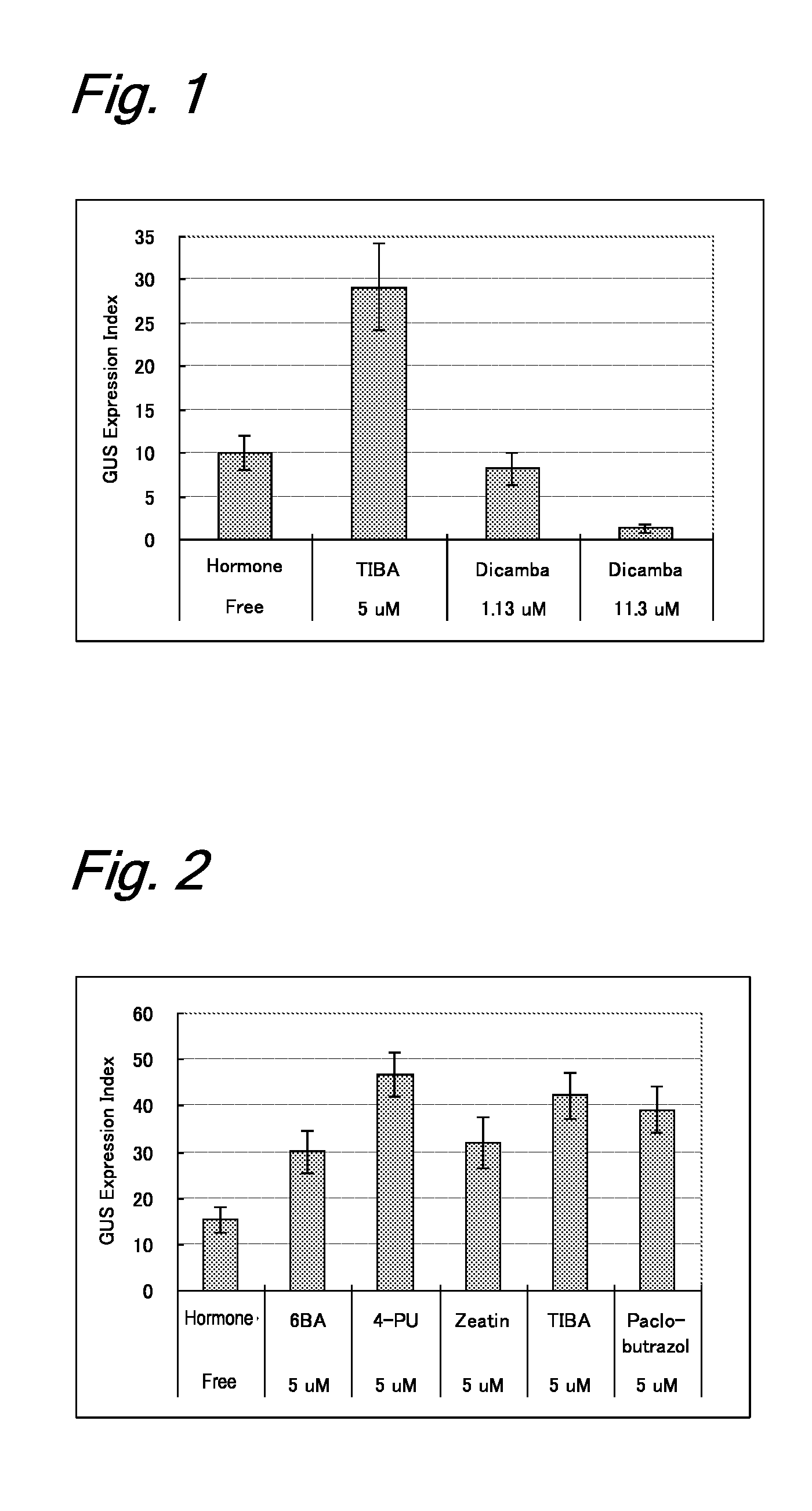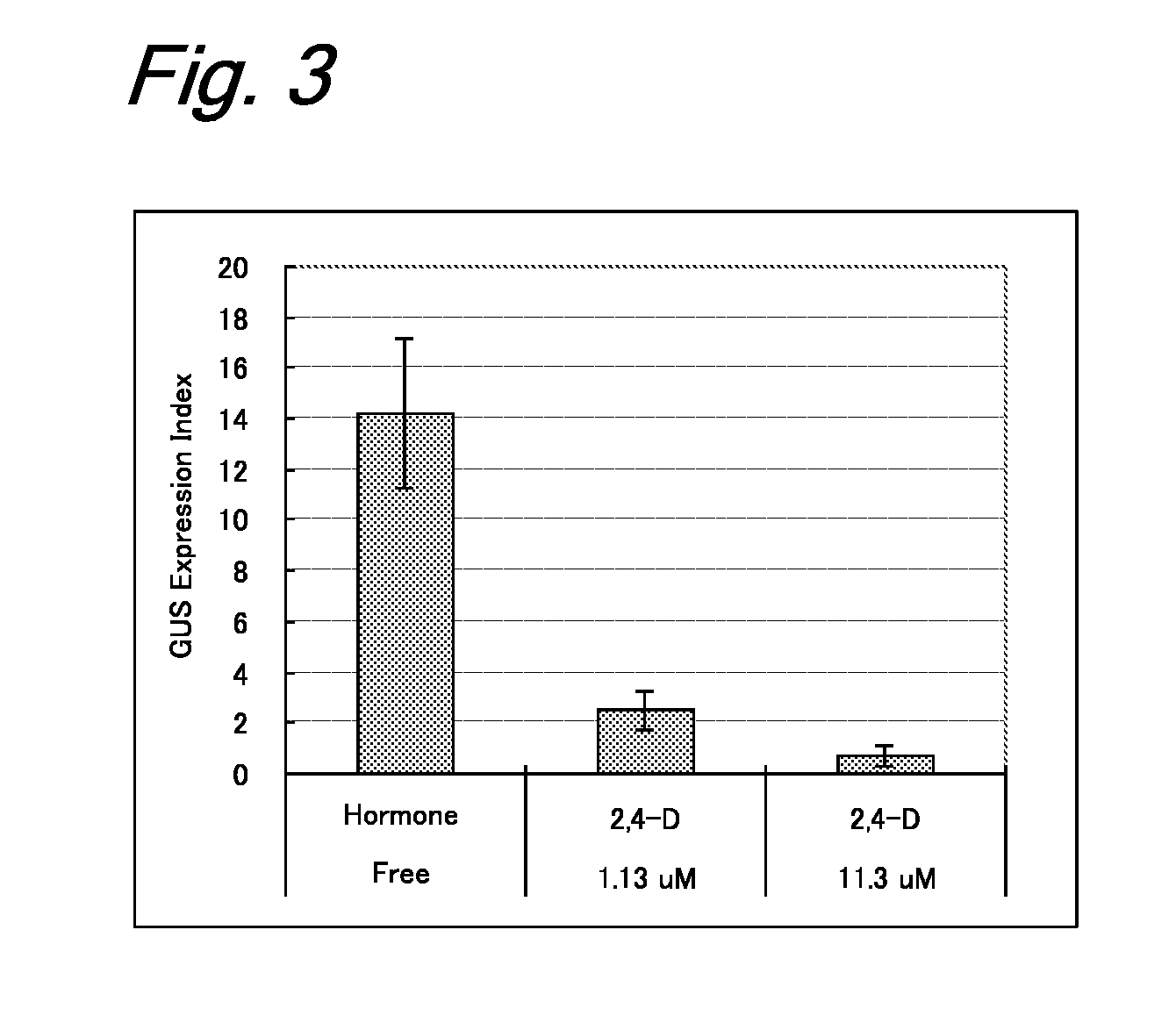Method for gene introduction into hordeum plant using agrobacterium, and method for production of transformed plant of hordeum plant
a technology of hordeum plant and gene introduction, which is applied in the field of gene introduction into hordeum plant using agrobacterium, and the method of production of transformed plant of hordeum plant, can solve the problems of inability to increase the transformation efficiency, inability to stably achieve, and inability to sterility or malformation of seeds, etc., and achieves high reproducibility, high efficiency, and reduced cost of obtaining the plant body
- Summary
- Abstract
- Description
- Claims
- Application Information
AI Technical Summary
Benefits of technology
Problems solved by technology
Method used
Image
Examples
example 1
Effect of Coculture Medium Composition on Gene Introduction Efficiency (Antiauxin, Auxin)
[0204]Material and Method
[0205]Immature embryos (size: 1.5 to 2.0 mm) of barley (variety: Golden Promise) from which embryonic axes were removed were aseptically collected and were immersed in 1 mL of sterilized water in a 2-mL microtube. In order to enhance the gene introduction efficiency, the tube containing the immature embryos was heated in a water bath at 43° C. for 5 minutes. An Agrobacterium strain EHA101 having a hygromycin resistance gene (pIG121Hm) (Non-Patent Literature 2) was suspended in an MG / L liquid medium (Non-Patent Literature 28) containing 100 μM acetosyringone and was shake-cultured (180 rpm) at 28° C. overnight (about 20 hours) to prepare an inoculation source. The bacterial concentration was adjusted to an O.D. of 1.0 (660 nm). The inoculation source was added to the thermal-treated immature embryos, and a reduced pressure treatment was performed with a vacuum pump at 500...
example 2
Effect of Coculture Medium Composition on Gene Introduction Efficiency (Cytokinin, Antiauxin)
[0209]Material and Method
[0210]The materials and the method of inoculation with Agrobacterium were the same as those in Example 1. The coculture medium used consisted of six test groups containing different five plant growth regulators: a hormone-free test group not containing any plant growth regulator; three test groups of cytokinins: 5 μM 6BA, 5 μM 4-PU, and 5 μM zeatin; and two test groups of antiauxins: 5 μM TIBA and 5 μM paclobutrazol. Immature embryos cultured at 25° C. in the dark for 24 hours were transplanted in a CIMT resting medium (Tingay et al., 1997: Non-Patent Literature 5) containing 0.5 mg / L of 2,4-D and 1.25 mg / L of CuSO4.5H2O, as in Example 1, and further containing 250 mg / L of carbenicillin and 100 mg / L of cefotaxime for Agrobacterium eradication. The immature embryos were cultured at 25° C. in the dark for 2 days and were then investigated for the expression of a GUS ge...
example 3
Effect of Centrifugation Treatment on Compact Callus Formation
[0213]Material and Method
[0214]The materials and the method of inoculation with Agrobacterium were the same as those in Example 1. The coculture medium did not contain any plant growth regulator. Immature embryos cocultured at 25° C. in the dark for 24 hours were transferred in a 2-mL microtube containing 1 mL of sterilized water and were centrifuged at 25° C. at 1500 rpm (20000×g) for 10 minutes. Subsequently, the immature embryos were transplanted in a CIMT resting medium (Tingay et al., 1997: Non-Patent Literature 5) containing 0.5 mg / L of 2,4-D and 1.25 mg / L of CuSO4.5H2O, as in Example 1. Meanwhile, the resting medium contained 250 mg / L of carbenicillin and 100 mg / L of cefotaxime for Agrobacterium eradication. The immature embryos were cultured at 25° C. in the dark for 2 days, and then the scutellum of each immature embryo was divided into four sections. The divided sections were transplanted in a medium having the ...
PUM
| Property | Measurement | Unit |
|---|---|---|
| Time | aaaaa | aaaaa |
| Time | aaaaa | aaaaa |
| Molar density | aaaaa | aaaaa |
Abstract
Description
Claims
Application Information
 Login to View More
Login to View More - R&D
- Intellectual Property
- Life Sciences
- Materials
- Tech Scout
- Unparalleled Data Quality
- Higher Quality Content
- 60% Fewer Hallucinations
Browse by: Latest US Patents, China's latest patents, Technical Efficacy Thesaurus, Application Domain, Technology Topic, Popular Technical Reports.
© 2025 PatSnap. All rights reserved.Legal|Privacy policy|Modern Slavery Act Transparency Statement|Sitemap|About US| Contact US: help@patsnap.com


